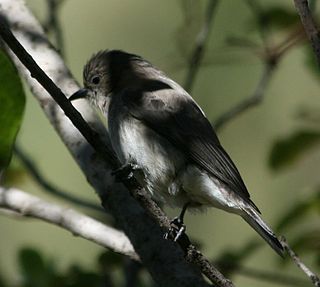
The African pipit is a fairly small passerine bird belonging to the pipit genus Anthus in the family Motacillidae. It is also known as the grassveld pipit or grassland pipit. It was formerly lumped together with the Richard's, Australian, mountain and paddyfield pipits in a single species, Richard's pipit, but is now often treated as a species in its own right.

The little rush warbler or African bush warbler is a species of Old World warbler in the family Locustellidae.

The green-capped eremomela or greencap eremomela is a species of bird formerly placed in the "Old World warbler" assemblage, but now placed in the family Cisticolidae.

Böhm's spinetail, also Bohm's spinetail or Boehm's spinetail,, also known as the bat-like spinetail, is a species of swift in the family Apodidae.

The square-tailed nightjar is a species of nightjar in the family Caprimulgidae which is native to tropical and subtropical woodlands of the Afrotropics. It has an extensive range south of the African equator. Despite not having a completely "square tail", its naming highlights a distinguishing field mark. The similarly plumaged slender-tailed nightjar, found in dry bush country of the tropics, differs namely by its protruding central tail feathers. It is alternatively known as the Gabon nightjar or Gaboon nightjar or the Mozambique nightjar.

The short-tailed pipit is a species of bird in the family Motacillidae. It is found in Angola, Burundi, Republic of the Congo, Democratic Republic of the Congo, Gabon, Mozambique, Rwanda, Somalia, South Africa, Tanzania, Uganda, Zambia, and Zimbabwe. Its natural habitats are subtropical or tropical dry lowland grassland and subtropical or tropical seasonally wet or flooded lowland grassland.

The bushveld pipit, also known as bush pipit or little pipit, is a species of bird in the pipit and wagtail family Motacillidae. It is found in Angola, Botswana, Eswatini, Ethiopia, Kenya, Malawi, Mozambique, South Africa, Tanzania, Zambia, and Zimbabwe. Its natural habitats are subtropical or tropical dry forests and dry savanna.

The buffy pipit is a species of bird in the Motacillidae family. It is found in plains and open countryside in southern and eastern Africa. The IUCN has assessed its conservation status as being of least concern.

The yellow-breasted apalis is a species of bird in the family Cisticolidae.

The lazy cisticola is a species of bird in the family Cisticolidae. It is widespread throughout sub-Saharan Africa.

The rattling cisticola is a species of bird in the family Cisticolidae which is native to Africa south of the equator, and parts of East Africa. It is a common to abundant species in open savanna and scrubland habitats, whether in arid, moist or upland regions. Especially during summer, it is highly conspicuous due to its strident and repetitive call-notes from prominent perches.

The red-capped robin-chat or Natal robin is a species of bird in the family Muscicapidae.

The white-browed scrub robin, also known as the red-backed scrub-robin, is a species of bird in the family Muscicapidae. It is native to sub-Saharan Africa, especially East and southern Africa. Within range, its Turdus-like song is one of the often-heard sounds of the bush. The flitting of the tail is characteristic of this species, but also of some near relatives.

The fan-tailed widowbird, also known as the red-shouldered widowbird, is a species of bird in the family Ploceidae, which is native to grassy and swampy areas of the tropical and subtropical Afrotropics.

The rosy-throated longclaw, also known as the rosy-breasted longclaw is a species of bird in the family Motacillidae. It is found in Angola, Botswana, Democratic Republic of the Congo, Kenya, Malawi, Mozambique, Namibia, South Africa, Tanzania, Zambia, and Zimbabwe. Its natural habitat is subtropical or tropical seasonally wet or flooded lowland grassland.

Retz's helmetshrike is a species of bird in the helmetshrike family Vangidae, formerly usually included in the Malaconotidae.

The brown-crowned tchagra is a species of bird in the family Malaconotidae.

The arrow-marked babbler is a species of bird in the family Leiothrichidae. It is native to woodlands in the southern Afrotropics.

The brown-backed honeybird, also known as Wahlberg's honeybird, Wahlberg's honeyguide and sharp-billed honeyguide, is a species of bird in the family Indicatoridae. This bird is named after the Swedish naturalist Johan August Wahlberg.

Englerophytum is a group of trees in the family Sapotaceae described as a genus in 1914.






















